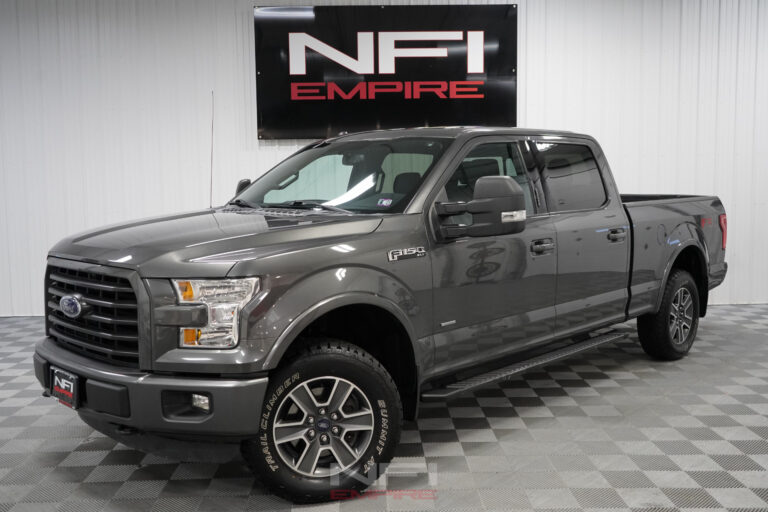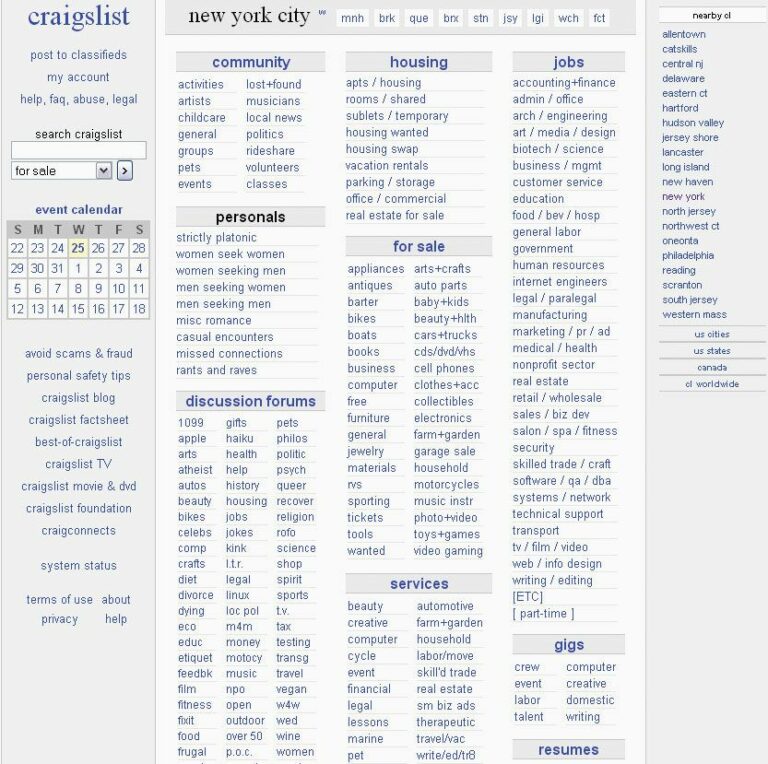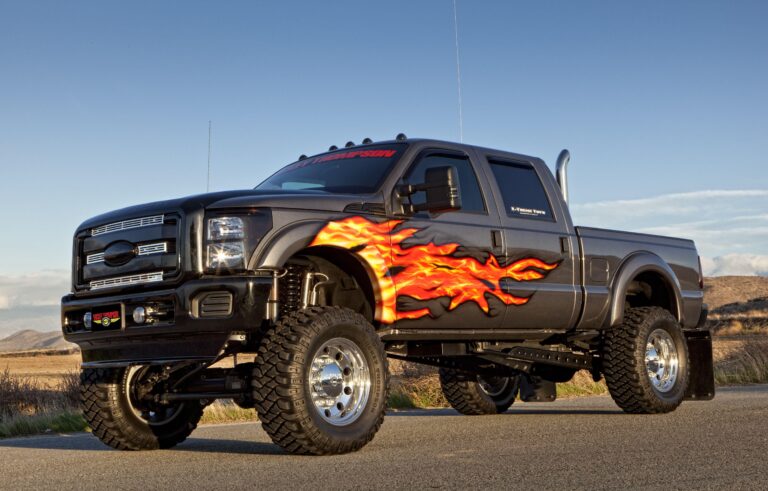How Many Parts For Trucks Are There: Unveiling the Microcosm of Modern Engineering
How Many Parts For Trucks Are There: Unveiling the Microcosm of Modern Engineering cars.truckstrend.com
Imagine a massive, gleaming semi-truck thundering down the highway, or a sturdy dump truck maneuvering through a construction site. These powerful machines, seemingly monolithic in their appearance, are in fact intricate ecosystems of thousands upon thousands of individual components working in perfect, complex harmony. The question "How many parts for trucks are there?" isn’t easily answered with a single number. It’s a journey into the astonishing world of automotive engineering, revealing layers of complexity from the largest structural elements down to the tiniest fasteners and microscopic circuits. Understanding this immense number is crucial for anyone involved in truck manufacturing, maintenance, repair, or even just appreciating the marvel of these indispensable vehicles that power our global economy.
The Sheer Scale: More Than Meets the Eye
How Many Parts For Trucks Are There: Unveiling the Microcosm of Modern Engineering
To truly grasp the number of parts in a truck, we must first define what constitutes a "part." Is a tire a part? Yes. Is a single lug nut holding that tire on also a part? Absolutely. What about a transistor inside an electronic control unit (ECU)? Technically, yes. When we consider a truck at this granular level, the numbers skyrocket.
A modern heavy-duty truck, like a Class 8 semi-trailer tractor, can comprise anywhere from 30,000 to over 50,000 distinct part numbers at the assembly level. However, if you break down every single component, including every bolt, washer, wire, circuit board component, and internal engine piece, this number can easily swell to hundreds of thousands, potentially even exceeding a million individual components. This includes everything from major assemblies like the engine block or transmission casing to the smallest O-rings, sensors, and even the individual strands of wire within a harness.
The variation in part count depends significantly on the truck’s type (light-duty pickup vs. heavy-duty vocational truck), its manufacturer, model, year of production, and the level of technological sophistication and optional features it incorporates. Newer trucks, with their advanced emissions systems, complex electronics, and sophisticated safety features, generally have a higher part count than their older, more mechanically-focused counterparts.
Breaking Down the Truck: Key Systems and Their Component Counts
To better understand this vast number, let’s dissect a typical truck into its primary systems, each a complex assembly of countless parts.
I. The Powertrain System: The Heartbeat of the Truck
The powertrain is arguably the most complex system, responsible for generating and delivering power to the wheels. It alone accounts for a significant portion of a truck’s total parts.
- Engine: This is a marvel of mechanical engineering, containing thousands of individual parts. Components include the engine block, cylinder heads (often two or more), pistons, connecting rods, crankshaft, camshaft(s), valves, springs, retainers, lifters, pushrods, injectors, glow plugs (for diesel), turbocharger(s), intercooler, exhaust manifold, intake manifold, oil pump, water pump, thermostat, a vast array of sensors (temperature, pressure, oxygen, crank position, cam position), fuel lines, oil lines, cooling hoses, belts, pulleys, and hundreds of nuts, bolts, and gaskets. A modern diesel engine alone can have well over 2,000 distinct part numbers.
- Transmission: Whether manual or automatic, the transmission is a highly intricate gearbox. It houses hundreds to thousands of parts, including gears, shafts, bearings, clutches (for manual), torque converter (for automatic), valve body (for automatic), solenoids, pumps, seals, and various sensors for speed and temperature.
- Driveshaft(s): Connects the transmission to the axles, consisting of shafts, universal joints (U-joints), and slip yokes.
- Drive Axles/Differential: Each drive axle assembly contains a differential (gears, bearings, housing), axle shafts, hubs, and bearings. Depending on the truck, there might be multiple drive axles.

II. The Chassis System: The Backbone and Foundation
The chassis provides the structural integrity and houses the systems for steering, suspension, and braking.
- Frame: Composed of two main rails and numerous crossmembers, all bolted or riveted together.
- Suspension System: This includes leaf springs, coil springs, shock absorbers, air bags (for air suspension), control arms, radius rods, torque rods, hangers, shackles, and various bushings and mounts.
- Steering System: Components include the steering wheel, steering column, steering gearbox (power steering pump, hoses, fluid reservoir), tie rods, drag links, pitman arm, idler arm, and steering knuckles.
- Braking System: Especially complex in heavy-duty trucks with air brakes. Parts include an air compressor, air tanks, air lines, brake chambers, slack adjusters, brake drums or rotors, brake shoes or pads, calipers, wheel cylinders, master cylinder (for hydraulic), ABS (Anti-lock Braking System) modules, sensors, and valves.
- Wheels and Tires: Each wheel assembly includes the rim, tire, inner tube (for some types), valve stem, and numerous lug nuts.
III. The Cab and Interior System: The Driver’s Command Center
The cab is the truck’s operational hub and living space, filled with components for comfort, control, and safety.
- Cab Structure: Panels, pillars, roof, floor, doors, windows, and their respective mechanisms (hinges, latches, power window motors).
- Interior Components: Dashboard, instrument cluster (gauges, lights), steering wheel, seats (often multi-adjustable with air suspension), pedals, HVAC (heating, ventilation, air conditioning) system (blower motor, evaporator, condenser, compressor, ducts, controls), infotainment system, communication systems, storage compartments, and various trim pieces.
- Safety Systems: Seatbelts, airbags (and their sensors and modules), safety glass.
- Wiring: Miles of wiring harnesses connecting every electrical component within the cab.
IV. Electrical and Electronic Systems: The Brain and Nervous System
Modern trucks are highly dependent on sophisticated electrical and electronic systems, which account for an ever-increasing number of parts.
- Power Generation/Storage: Battery(ies), alternator, starter motor.
- Wiring Harnesses: An incredibly complex network of wires, connectors, fuses, and relays, spanning the entire truck. Each connector, terminal, and fuse is a distinct part.
- Electronic Control Units (ECUs): Multiple computers control different aspects: Engine Control Unit (ECU/ECM), Transmission Control Unit (TCU), Body Control Module (BCM), Anti-lock Braking System (ABS) module, Airbag Control Module, and various other specialized modules. Each ECU is a sophisticated circuit board with hundreds of micro-components (resistors, capacitors, microprocessors, memory chips).
- Sensors: Hundreds of sensors monitor everything from engine temperature and oil pressure to wheel speed, exhaust gas composition, and driver inputs (pedal position, steering angle).
- Lighting: Headlights, tail lights, marker lights, turn signals, interior lights – each with bulbs (or LEDs), housings, lenses, and wiring.
V. Ancillary Systems and Accessories: The Support Crew
These systems, while sometimes overlooked, are crucial for the truck’s operation and specific functions.
- Fuel System: Fuel tank(s), fuel pump(s), fuel filters, fuel lines, and associated sensors.
- Exhaust System: Exhaust manifold, downpipe, catalytic converter(s), Diesel Particulate Filter (DPF), Selective Catalytic Reduction (SCR) system (for emissions), muffler, and exhaust pipes.
- Cooling System: Radiator, fan, fan clutch, coolant hoses, expansion tank.
- Wiper and Washer System: Wiper blades, wiper arms, wiper motor, washer fluid reservoir, washer pump, spray nozzles.
- Mirrors: Side mirrors (often heated and power-adjustable), rear-view mirror.
- Specialized Equipment: For vocational trucks (e.g., dump trucks, cement mixers, refuse trucks), additional hydraulic systems (pumps, cylinders, hoses, valves), Power Take-Off (PTO) units, and specific body components add thousands more parts.
Factors Influencing Part Count
The exact number of parts varies significantly based on several key factors:
- Truck Type and Class: A light-duty pickup truck will have considerably fewer parts than a Class 8 heavy-duty tractor-trailer or a specialized vocational truck.
- Engine and Transmission Type: Diesel engines are generally more complex than gasoline engines, and automatic transmissions can have more electronic components than manual ones.
- Technological Advancement: Newer trucks with advanced driver-assistance systems (ADAS), complex emissions controls (e.g., SCR, DPF), and extensive infotainment systems will have a higher count of electronic and sensor-related parts.
- Customization and Aftermarket Additions: Any factory options or aftermarket modifications (e.g., auxiliary lighting, custom interiors, specialized hauling equipment) will add to the overall part count.
The Importance of Knowing Your Parts
Understanding the sheer number and complexity of truck parts is not just a trivia fact; it has profound practical implications:
- Maintenance and Repair: Knowing which parts belong to which system helps in accurate diagnosis and sourcing the correct replacement components, a critical factor in minimizing downtime.
- Cost Estimation: The multitude of parts directly influences repair costs. Even small, seemingly insignificant parts can be expensive due to their specialized nature or critical function.
- Troubleshooting: A systematic understanding of how systems are interconnected allows technicians to efficiently pinpoint the root cause of a problem.
- Safety: Every part plays a role in the truck’s overall safety. Regular inspection and timely replacement of worn or damaged parts are paramount.
- Inventory Management: For fleet managers and repair shops, managing an inventory of thousands of different part numbers is a complex logistical challenge.
Challenges and Solutions in Managing Truck Parts
The vast number of parts presents several challenges:
- Vast Inventory: Storing and organizing thousands of unique parts requires significant space and sophisticated inventory systems.
- Obsolescence: As truck models evolve, older parts become obsolete, making them harder to find and more expensive.
- Counterfeit Parts: The market for truck parts can be infiltrated by counterfeit components, which are often inferior in quality and can compromise safety and performance.
- Supply Chain Issues: Global events can disrupt the supply chain, leading to shortages and delays for critical parts.
Solutions involve utilizing digital parts catalogs (often VIN-specific), establishing strong relationships with reputable OEM (Original Equipment Manufacturer) and aftermarket suppliers, implementing robust inventory management software, and continuously training technicians to identify and work with new technologies and components.
Practical Advice and Actionable Insights
For truck owners, operators, and maintenance professionals, here’s some practical advice:
- Consult Your Manuals: The owner’s manual and service manuals are invaluable resources for understanding your truck’s specific components and recommended maintenance.
- Utilize VIN-Specific Parts Lookups: When ordering parts, always use your truck’s Vehicle Identification Number (VIN) to ensure compatibility. Online parts catalogs often allow VIN-based searches.
- Understand OEM vs. Aftermarket: OEM parts are made by the original manufacturer, while aftermarket parts are produced by other companies. Both have pros and cons regarding cost, quality, and availability. Choose wisely based on the part’s criticality and your budget.
- Don’t Underestimate Small Parts: Fasteners, seals, O-rings, and small electrical connectors might seem minor, but their failure can lead to significant issues. Always use the correct type and torque specifications.
- Regular Inspections: Proactive inspections can identify worn parts before they fail catastrophically, saving time, money, and potential safety hazards.
Illustrative Price Ranges for Truck Parts Categories (Conceptual)
It is impossible to provide a "complete" price table for all truck parts, as there are hundreds of thousands of distinct components, and prices fluctuate based on manufacturer, quality (OEM vs. aftermarket), supplier, and market conditions. However, the table below offers a conceptual overview of typical price ranges for different categories of truck parts to give an idea of the financial scale involved.
| Part Category/System | Examples of Parts | Typical Price Range (Each/Assembly)* | Notes/Impact |
|---|---|---|---|
| Powertrain | Engine Injector, Turbocharger, Water Pump, Gasket Set | $50 – $5,000+ | Core for truck movement; high-cost, critical components. |
| Transmission | Clutch Kit (manual), Valve Body (auto), Gears | $300 – $8,000+ | Essential for power delivery; labor-intensive replacement. |
| Chassis/Frame | Crossmember, Frame Section, Cab Mounts | $100 – $2,000+ | Structural integrity; often requires specialized repair. |
| Suspension | Leaf Spring, Air Bag, Shock Absorber, Control Arm | $50 – $1,000+ | Affects ride quality, handling, and load capacity. |
| Braking System | Brake Pad Set, Rotor, Air Brake Chamber, ABS Sensor | $100 – $1,500+ | Safety-critical; regular wear item. |
| Steering System | Steering Gearbox, Power Steering Pump, Tie Rod End | $70 – $2,000+ | Critical for control and maneuverability. |
| Electrical/Electronic | Battery, Alternator, Starter, ECU (module), Sensor | $20 – $5,000+ | Wide range depending on complexity; diagnostics often required. |
| Cab & Interior | Seat (assembly), Dashboard, HVAC Blower Motor, Door Actuator | $50 – $2,500+ | Driver comfort, safety, and operational controls. |
| Fuel System | Fuel Tank, Fuel Pump, Fuel Filter, Fuel Injector | $30 – $1,000+ | Delivers fuel to the engine; emissions compliance. |
| Exhaust System | Muffler, DPF Filter, SCR System, O2 Sensor | $50 – $5,000+ | Emissions control; can be very expensive. |
| Cooling System | Radiator, Fan Clutch, Water Pump, Hoses | $50 – $1,000+ | Prevents engine overheating; crucial for engine longevity. |
| Wheels & Tires | Truck Tire, Rim (Steel/Aluminum), Lug Nuts | $20 – $800+ | Regular wear item; critical for safety and traction. |
| Small Parts/Hardware | Bolts, Nuts, Washers, Gaskets, O-rings, Clips | $1 – $50+ | Numerous; often overlooked but critical for proper assembly and sealing. |
*Disclaimer: Prices are highly illustrative and subject to significant variation based on brand, quality, specific truck model, supplier, and market conditions. Labor costs for installation are not included.
Frequently Asked Questions (FAQ)
Q1: Is it possible to get an exact count of parts in a specific truck model?
A1: While manufacturers have internal databases that track every single part number, a publicly available, definitive "exact count" for a fully assembled truck is generally not provided due to the sheer complexity and the dynamic nature of bill of materials (BOMs) which can change even within a model year. Estimates ranging from tens of thousands to over a million individual components are used to convey the scale.
Q2: Do different truck brands have vastly different part counts?
A2: While the general categories of parts are similar across brands (engine, transmission, chassis, etc.), the exact number of unique part numbers will vary due to different engineering designs, proprietary technologies, and component sourcing. However, the overall magnitude of parts remains in the tens to hundreds of thousands.
Q3: Which part of a truck has the most individual components?
A3: The engine is typically the most complex single assembly, containing thousands of individual components. However, when considering the total number of unique part numbers, the electrical and electronic systems (including wiring harnesses, ECUs, and hundreds of sensors and connectors) collectively account for an enormous portion of the overall part count.
Q4: How does technology affect the number of parts in a truck?
A4: Modern technology, particularly in electronics, significantly increases part count. Advanced emissions control systems (like DPFs and SCRs), sophisticated engine and transmission control units, complex infotainment systems, and numerous safety sensors (e.g., for ADAS features like lane keeping, adaptive cruise control) add hundreds to thousands of new components that were not present in older, more mechanically simpler trucks.
Q5: Are small fasteners like nuts and bolts counted as individual parts?
A5: Yes, in a comprehensive breakdown, every unique fastener, washer, O-ring, clip, and seal is counted as a distinct part number. These small components, though individually inexpensive, are crucial for the integrity and function of the larger assemblies and contribute significantly to the overall part count.
Q6: How can I find the right part for my specific truck?
A6: The most reliable method is to use your truck’s Vehicle Identification Number (VIN) with an OEM parts catalog or a reputable aftermarket parts supplier’s lookup system. The VIN precisely identifies your truck’s make, model, year, and specific configurations, ensuring you get the correct part.
Conclusion
The question "How many parts for trucks are there?" opens a window into the incredible complexity of modern heavy machinery. Far from being simple, a single truck is a masterpiece of engineering, comprised of tens of thousands of distinct assemblies and components, and potentially over a million individual pieces if broken down to their most fundamental elements. From the thundering power of the engine to the intricate network of wires and sensors, each part plays a vital role in the truck’s performance, safety, and efficiency. This astounding number underscores the ingenuity behind their design, the precision required in their manufacturing, and the expertise needed for their maintenance, reminding us that these titans of the road are truly a marvel of our technological age.






